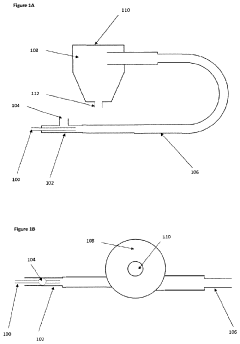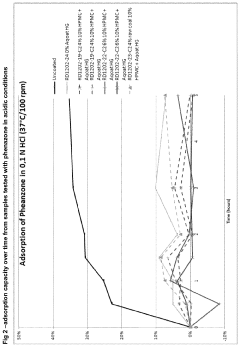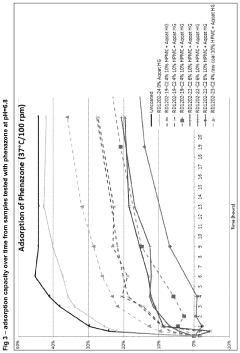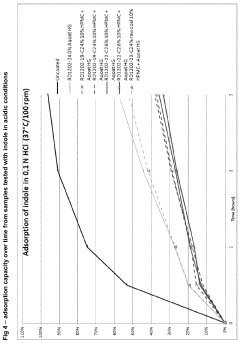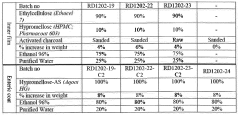How Activated Carbon Adsorption Meets Food/Pharma Compliance For Product-Contact Streams?
SEP 17, 20259 MIN READ
Generate Your Research Report Instantly with AI Agent
Patsnap Eureka helps you evaluate technical feasibility & market potential.
Activated Carbon Adsorption Technology Evolution and Objectives
Activated carbon adsorption technology has evolved significantly since its initial applications in water purification during the early 20th century. The fundamental principle of activated carbon's high surface area creating adsorption sites for contaminants has remained consistent, while manufacturing processes and applications have diversified considerably. Initially derived primarily from coconut shells and wood, activated carbon production has expanded to include coal, petroleum coke, and various agricultural byproducts, each offering specific performance characteristics for different applications.
The 1970s marked a pivotal era with the implementation of the Clean Water Act and Safe Drinking Water Act in the United States, which accelerated research and development in activated carbon technologies for contaminant removal. By the 1990s, activated carbon had become a standard treatment technology in municipal water systems and was increasingly adopted in food and pharmaceutical processing applications.
Recent technological advancements have focused on enhancing selectivity, capacity, and regeneration capabilities. Modified activated carbons with tailored surface chemistries have emerged, offering improved performance for specific contaminants relevant to food and pharmaceutical applications. These include carbons with enhanced removal capabilities for pesticides, antibiotics, endocrine disruptors, and process-related compounds that could compromise product quality or safety.
The current trajectory of activated carbon technology development is moving toward more sustainable production methods, improved regeneration techniques to extend service life, and advanced characterization methods that ensure consistent performance in critical applications. Computational modeling of adsorption mechanisms has also enabled more precise prediction of carbon performance in complex fluid streams typical in food and pharmaceutical processing.
The primary objective of modern activated carbon adsorption technology in food and pharmaceutical applications is to achieve reliable contaminant removal while maintaining strict compliance with regulatory standards such as FDA 21 CFR, USP <661>, EP 3.1.1.1, and ISO 22000. This includes ensuring that the carbon itself does not introduce harmful substances into the product stream, a concern that has driven the development of specialized food-grade and pharmaceutical-grade activated carbons.
Secondary objectives include optimizing process economics through improved adsorption efficiency, reduced replacement frequency, and minimized pressure drop. Additionally, there is growing emphasis on developing activated carbon solutions that can be validated within quality systems and documented to meet the increasingly stringent requirements of regulatory audits in food and pharmaceutical manufacturing environments.
The 1970s marked a pivotal era with the implementation of the Clean Water Act and Safe Drinking Water Act in the United States, which accelerated research and development in activated carbon technologies for contaminant removal. By the 1990s, activated carbon had become a standard treatment technology in municipal water systems and was increasingly adopted in food and pharmaceutical processing applications.
Recent technological advancements have focused on enhancing selectivity, capacity, and regeneration capabilities. Modified activated carbons with tailored surface chemistries have emerged, offering improved performance for specific contaminants relevant to food and pharmaceutical applications. These include carbons with enhanced removal capabilities for pesticides, antibiotics, endocrine disruptors, and process-related compounds that could compromise product quality or safety.
The current trajectory of activated carbon technology development is moving toward more sustainable production methods, improved regeneration techniques to extend service life, and advanced characterization methods that ensure consistent performance in critical applications. Computational modeling of adsorption mechanisms has also enabled more precise prediction of carbon performance in complex fluid streams typical in food and pharmaceutical processing.
The primary objective of modern activated carbon adsorption technology in food and pharmaceutical applications is to achieve reliable contaminant removal while maintaining strict compliance with regulatory standards such as FDA 21 CFR, USP <661>, EP 3.1.1.1, and ISO 22000. This includes ensuring that the carbon itself does not introduce harmful substances into the product stream, a concern that has driven the development of specialized food-grade and pharmaceutical-grade activated carbons.
Secondary objectives include optimizing process economics through improved adsorption efficiency, reduced replacement frequency, and minimized pressure drop. Additionally, there is growing emphasis on developing activated carbon solutions that can be validated within quality systems and documented to meet the increasingly stringent requirements of regulatory audits in food and pharmaceutical manufacturing environments.
Market Demand Analysis for Food and Pharmaceutical Purification
The global market for activated carbon in food and pharmaceutical purification applications is experiencing robust growth, driven by increasingly stringent regulatory requirements and heightened consumer awareness regarding product safety and quality. Current market valuations indicate that the activated carbon market specific to food and pharmaceutical applications exceeds $1.2 billion annually, with a compound annual growth rate of approximately 7.8% projected through 2028.
Food industry demand is primarily fueled by the need for purification in beverage production, particularly in alcohol distillation, juice clarification, and water treatment processes. Major food manufacturers are increasingly implementing activated carbon filtration systems to remove organic contaminants, off-flavors, colors, and odors from their production streams. This trend is particularly pronounced in premium and organic product segments, where purity standards are exceptionally high.
In the pharmaceutical sector, activated carbon plays a critical role in API (Active Pharmaceutical Ingredient) purification, where even trace contaminants can compromise drug efficacy and safety. The industry's shift toward more complex biological pharmaceuticals has further intensified the need for advanced purification technologies. Activated carbon's ability to remove pyrogens, endotoxins, and other biological contaminants makes it indispensable in parenteral drug manufacturing processes.
Regulatory developments have significantly shaped market demand patterns. The FDA's Food Safety Modernization Act (FSMA) in the United States and similar regulations globally have established more rigorous standards for contaminant removal in food processing. Similarly, pharmaceutical manufacturers must comply with cGMP (current Good Manufacturing Practices) guidelines, which mandate effective purification of product-contact streams.
Regional analysis reveals that North America and Europe currently dominate market consumption, accounting for over 60% of global demand. However, the Asia-Pacific region is witnessing the fastest growth rate, driven by rapid industrialization in China and India's expanding pharmaceutical manufacturing base.
Consumer trends are also reshaping the market landscape. The growing preference for "clean label" products has prompted food manufacturers to adopt natural purification methods like activated carbon over synthetic alternatives. Similarly, the pharmaceutical industry's focus on sustainability has increased interest in renewable activated carbon sources derived from coconut shells, wood, and other biomass materials.
Industry surveys indicate that over 78% of food and pharmaceutical manufacturers consider purification technology a critical factor in their production processes, with activated carbon consistently ranking among the preferred solutions due to its versatility, effectiveness, and relatively low operational costs compared to alternative technologies.
Food industry demand is primarily fueled by the need for purification in beverage production, particularly in alcohol distillation, juice clarification, and water treatment processes. Major food manufacturers are increasingly implementing activated carbon filtration systems to remove organic contaminants, off-flavors, colors, and odors from their production streams. This trend is particularly pronounced in premium and organic product segments, where purity standards are exceptionally high.
In the pharmaceutical sector, activated carbon plays a critical role in API (Active Pharmaceutical Ingredient) purification, where even trace contaminants can compromise drug efficacy and safety. The industry's shift toward more complex biological pharmaceuticals has further intensified the need for advanced purification technologies. Activated carbon's ability to remove pyrogens, endotoxins, and other biological contaminants makes it indispensable in parenteral drug manufacturing processes.
Regulatory developments have significantly shaped market demand patterns. The FDA's Food Safety Modernization Act (FSMA) in the United States and similar regulations globally have established more rigorous standards for contaminant removal in food processing. Similarly, pharmaceutical manufacturers must comply with cGMP (current Good Manufacturing Practices) guidelines, which mandate effective purification of product-contact streams.
Regional analysis reveals that North America and Europe currently dominate market consumption, accounting for over 60% of global demand. However, the Asia-Pacific region is witnessing the fastest growth rate, driven by rapid industrialization in China and India's expanding pharmaceutical manufacturing base.
Consumer trends are also reshaping the market landscape. The growing preference for "clean label" products has prompted food manufacturers to adopt natural purification methods like activated carbon over synthetic alternatives. Similarly, the pharmaceutical industry's focus on sustainability has increased interest in renewable activated carbon sources derived from coconut shells, wood, and other biomass materials.
Industry surveys indicate that over 78% of food and pharmaceutical manufacturers consider purification technology a critical factor in their production processes, with activated carbon consistently ranking among the preferred solutions due to its versatility, effectiveness, and relatively low operational costs compared to alternative technologies.
Current Compliance Challenges in Product-Contact Applications
The food and pharmaceutical industries face increasingly stringent regulatory requirements regarding product-contact materials, with activated carbon adsorption systems presenting unique compliance challenges. Current FDA, USDA, and EU regulations mandate that all materials coming into direct contact with food or pharmaceutical products must be demonstrably safe, inert, and free from potential contaminants that could migrate into the final product. For activated carbon systems, this creates a complex compliance landscape that manufacturers must navigate.
One significant challenge is the variability in raw material sources for activated carbon production. Carbon derived from coconut shells, wood, coal, or petroleum can contain different impurity profiles, potentially introducing unwanted substances into product streams. Manufacturers struggle to maintain consistent quality and purity across different carbon batches, complicating validation processes required by regulatory bodies.
Documentation requirements present another major hurdle. Companies must maintain comprehensive records demonstrating that their activated carbon systems meet all applicable standards, including USP <661>, EP 3.1, and ISO 10993 for pharmaceutical applications, or FDA 21 CFR 177 for food contact materials. The burden of proof lies with the manufacturer to demonstrate that no harmful substances will leach into product streams under normal operating conditions.
Validation protocols for activated carbon systems are particularly challenging due to the material's inherent adsorptive properties. Standard extraction studies may not accurately represent real-world conditions, as activated carbon's behavior changes throughout its service life. This creates uncertainty in compliance testing and necessitates more complex validation approaches than those used for simpler materials.
Cross-contamination risks pose additional compliance concerns. Activated carbon that has previously been used in industrial applications may contain residual contaminants that could migrate into food or pharmaceutical products. Ensuring proper segregation of manufacturing processes and implementing rigorous cleaning validation protocols are essential but resource-intensive requirements.
Emerging regulations around nanomaterials add another layer of complexity. Some activated carbon products contain particles in the nanometer range, potentially triggering additional regulatory scrutiny under newer frameworks like the EU's nanomaterial regulations. Manufacturers must now consider particle size distribution in their compliance documentation, often requiring specialized analytical techniques.
Global regulatory harmonization remains elusive, with different regions maintaining distinct requirements for product-contact materials. Companies operating internationally must navigate this fragmented regulatory landscape, often necessitating multiple compliance strategies for identical products sold in different markets.
One significant challenge is the variability in raw material sources for activated carbon production. Carbon derived from coconut shells, wood, coal, or petroleum can contain different impurity profiles, potentially introducing unwanted substances into product streams. Manufacturers struggle to maintain consistent quality and purity across different carbon batches, complicating validation processes required by regulatory bodies.
Documentation requirements present another major hurdle. Companies must maintain comprehensive records demonstrating that their activated carbon systems meet all applicable standards, including USP <661>, EP 3.1, and ISO 10993 for pharmaceutical applications, or FDA 21 CFR 177 for food contact materials. The burden of proof lies with the manufacturer to demonstrate that no harmful substances will leach into product streams under normal operating conditions.
Validation protocols for activated carbon systems are particularly challenging due to the material's inherent adsorptive properties. Standard extraction studies may not accurately represent real-world conditions, as activated carbon's behavior changes throughout its service life. This creates uncertainty in compliance testing and necessitates more complex validation approaches than those used for simpler materials.
Cross-contamination risks pose additional compliance concerns. Activated carbon that has previously been used in industrial applications may contain residual contaminants that could migrate into food or pharmaceutical products. Ensuring proper segregation of manufacturing processes and implementing rigorous cleaning validation protocols are essential but resource-intensive requirements.
Emerging regulations around nanomaterials add another layer of complexity. Some activated carbon products contain particles in the nanometer range, potentially triggering additional regulatory scrutiny under newer frameworks like the EU's nanomaterial regulations. Manufacturers must now consider particle size distribution in their compliance documentation, often requiring specialized analytical techniques.
Global regulatory harmonization remains elusive, with different regions maintaining distinct requirements for product-contact materials. Companies operating internationally must navigate this fragmented regulatory landscape, often necessitating multiple compliance strategies for identical products sold in different markets.
Established Compliance Frameworks for Food/Pharma Contact Materials
01 Activated carbon adsorption systems for environmental compliance
Activated carbon adsorption systems are designed to meet environmental regulations by removing contaminants from air and water. These systems incorporate specialized carbon materials with high adsorption capacity to capture pollutants such as volatile organic compounds (VOCs), heavy metals, and other harmful substances. The systems are engineered with specific flow rates, contact times, and carbon bed configurations to ensure compliance with emission standards and discharge limits.- Activated carbon adsorption systems for environmental compliance: Activated carbon adsorption systems are designed to meet environmental regulations by removing contaminants from air and water. These systems incorporate specialized carbon materials with high adsorption capacity to capture pollutants such as volatile organic compounds (VOCs), heavy metals, and other harmful substances. The systems often include monitoring capabilities to ensure continuous compliance with emission standards and environmental protection requirements.
- Regeneration and reactivation methods for regulatory compliance: Various methods for regenerating and reactivating spent activated carbon ensure continued compliance with regulatory standards while extending the carbon's useful life. These techniques include thermal regeneration, chemical treatment, and steam activation processes that restore adsorption capacity. Proper regeneration protocols are essential for maintaining compliance with waste management regulations and reducing the environmental impact of carbon disposal.
- Monitoring and quality control systems for compliance verification: Advanced monitoring and quality control systems are implemented to verify compliance of activated carbon adsorption processes. These systems include real-time sensors, automated sampling mechanisms, and data management platforms that track adsorption efficiency, breakthrough curves, and contaminant levels. Continuous monitoring ensures that treatment systems maintain regulatory compliance and provides documentation for reporting requirements.
- Specialized activated carbon formulations for regulatory standards: Specialized activated carbon formulations are developed to meet specific regulatory standards across different industries. These include modified carbon materials with enhanced selectivity for target contaminants, impregnated carbons with chemical additives to improve adsorption of specific compounds, and engineered particle sizes for optimized flow characteristics. These formulations are designed to achieve compliance with increasingly stringent environmental regulations.
- Integrated treatment systems for comprehensive compliance: Integrated treatment systems combine activated carbon adsorption with complementary technologies to ensure comprehensive regulatory compliance. These systems may incorporate pre-treatment processes, multiple adsorption stages, and post-treatment technologies to address complex contamination challenges. The integration of various treatment methods enhances overall removal efficiency and helps facilities meet multiple compliance requirements simultaneously.
02 Carbon modification techniques for enhanced regulatory compliance
Various modification techniques can be applied to activated carbon to enhance its adsorption properties for specific contaminants, thereby improving regulatory compliance. These modifications include chemical impregnation, surface functionalization, and thermal treatment. Modified carbons can achieve higher removal efficiencies for targeted pollutants, allowing facilities to meet stricter compliance standards with smaller treatment systems or lower carbon usage rates.Expand Specific Solutions03 Monitoring and control systems for compliance verification
Advanced monitoring and control systems are integrated with activated carbon adsorption units to ensure continuous compliance with regulatory requirements. These systems include real-time sensors, automated sampling devices, and data management software that track contaminant levels, carbon saturation, and system performance. Automated alerts and reporting functions help operators maintain compliance by signaling when maintenance or carbon replacement is needed before breakthrough occurs.Expand Specific Solutions04 Regeneration and disposal protocols for compliance management
Proper regeneration and disposal protocols for spent activated carbon are essential for maintaining regulatory compliance throughout the carbon lifecycle. These protocols include thermal regeneration methods, chemical washing procedures, and proper handling of waste carbon. Implementing appropriate regeneration and disposal practices ensures that facilities comply with waste management regulations while optimizing the economic and environmental performance of carbon adsorption systems.Expand Specific Solutions05 Specialized carbon formulations for industry-specific compliance
Specialized activated carbon formulations are developed to address industry-specific compliance challenges in sectors such as pharmaceuticals, food processing, and chemical manufacturing. These tailored carbons feature specific pore size distributions, surface chemistries, and physical properties designed to target regulated compounds unique to each industry. By using industry-specific carbon formulations, facilities can achieve more efficient compliance with sector-specific regulations and standards.Expand Specific Solutions
Leading Manufacturers and Suppliers in Compliant Carbon Solutions
The activated carbon adsorption market for food and pharmaceutical compliance is in a growth phase, driven by increasing regulatory standards and demand for purification solutions. The market is characterized by a mix of established players and specialized innovators. Key companies like Kuraray, Osaka Gas Chemicals, and Blücher GmbH lead with advanced technical capabilities in developing compliant activated carbon solutions. The technology has reached moderate maturity with ongoing innovations focused on enhancing adsorption efficiency, reducing contaminants, and meeting specific industry requirements. Companies such as Futamura Chemical and CSP Technologies are advancing specialized applications for food-contact materials, while pharmaceutical compliance is addressed by firms like Ferring BV and Axial Therapeutics through tailored purification systems.
Kuraray Co., Ltd.
Technical Solution: Kuraray has developed proprietary activated carbon technologies specifically designed for food and pharmaceutical applications. Their GC series activated carbon products feature controlled pore size distribution optimized for adsorption of contaminants while maintaining compliance with FDA regulations and pharmaceutical standards. Kuraray's technology employs a multi-stage activation process that creates a highly developed micropore structure (0.6-2.0 nm) ideal for removing organic impurities from product streams. Their activated carbon materials undergo rigorous quality control testing to ensure they meet USP <661.1> and EU 10/2011 compliance requirements for product-contact applications. The company has also developed specialized washing and post-treatment processes that reduce extractables and leachables to levels well below regulatory thresholds, making their products suitable for direct food and pharmaceutical contact.
Strengths: Superior micropore structure control allowing targeted adsorption of specific contaminants; extensive regulatory compliance documentation; high purity grades with minimal extractables. Weaknesses: Higher cost compared to conventional activated carbons; limited customization options for specialized applications; longer lead times for pharmaceutical-grade products.
BLÜCHER GmbH
Technical Solution: BLÜCHER, a Kuraray subsidiary, has pioneered spherical activated carbon technology specifically engineered for pharmaceutical and food processing applications. Their SARATECH® product line features uniform spherical carbon beads with controlled particle size distribution (0.15-0.85 mm) and exceptional mechanical strength, allowing for high flow rates without pressure drop issues common in granular carbons. The spherical structure provides superior mass transfer kinetics, increasing adsorption efficiency by up to 40% compared to conventional activated carbons. BLÜCHER's proprietary steam activation process creates a balanced micro/mesopore structure ideal for removing both small molecular weight impurities and larger organic compounds from product streams. Their activated carbon meets EP 3.1.1.1 and USP <661.1> requirements and is certified for compliance with FDA 21 CFR 177.2800 for food-contact applications. The company's manufacturing process includes specialized cleaning steps that reduce metal content to <10 ppm, critical for pharmaceutical applications.
Strengths: Superior mechanical integrity reducing particle shedding; excellent flow characteristics in fixed bed systems; balanced pore structure for broad-spectrum contaminant removal. Weaknesses: Higher initial investment compared to traditional GAC systems; requires specialized handling during installation; limited availability in certain global regions.
Critical Patents and Innovations in Compliant Carbon Formulations
Pharmaceutical compositions
PatentPendingUS20240016753A1
Innovation
- A pharmaceutical composition comprising a core of activated carbon coated with an insoluble semipermeable material layer and an enteric layer that dissolves at a predetermined pH, allowing controlled release and minimizing adsorption of beneficial substances until reaching the site of action in the gastrointestinal tract.
Pharmaceutical composition
PatentWO2014044794A2
Innovation
- A pharmaceutical composition comprising a core of activated carbon, an insoluble semipermeable inner layer to allow gradual diffusion of irritants, and an enteric outer layer that dissolves at a predetermined pH in the gastrointestinal tract, minimizing adsorption of essential chemicals and maintaining adsorptive activity until reaching the site of action.
Regulatory Standards and Certification Requirements
Activated carbon adsorption systems in food and pharmaceutical applications must adhere to stringent regulatory frameworks established by international, regional, and national authorities. The U.S. Food and Drug Administration (FDA) mandates compliance with Current Good Manufacturing Practice (cGMP) regulations, specifically 21 CFR Parts 210 and 211 for pharmaceuticals and 21 CFR Part 117 for food processing. These regulations require that all materials contacting products must be demonstrably safe and non-contaminating.
The European Union enforces similar standards through EC 1935/2004 for food contact materials and EudraLex Volume 4 for pharmaceutical manufacturing. These regulations establish performance criteria for adsorption systems and require comprehensive validation protocols to ensure consistent removal of contaminants without introducing new impurities into product streams.
International standards organizations provide additional certification frameworks that manufacturers often pursue to demonstrate compliance. ISO 22000 addresses food safety management systems, while ISO 9001 certification ensures quality management practices. For pharmaceutical applications, USP <661> and USP <670> provide specific guidelines for materials used in manufacturing processes, including activated carbon filtration systems.
Material certifications represent another critical compliance aspect. Activated carbon used in these industries typically requires USP/NF or EP/BP certification, confirming it meets pharmacopeial standards. Additionally, NSF/ANSI 61 certification is often sought for systems used in beverage production to verify that materials do not leach harmful contaminants into the product stream.
Documentation requirements are extensive across all regulatory frameworks. Manufacturers must maintain detailed records of activated carbon specifications, validation studies, performance testing, and change control procedures. This includes certificates of analysis (CoA), material safety data sheets (MSDS), and traceability documentation from raw material to finished product.
Compliance verification involves regular auditing and testing protocols. This includes leachable/extractable testing to ensure no harmful substances migrate from the carbon into product streams, microbial testing to confirm the absence of biological contamination, and performance validation to verify consistent contaminant removal efficiency under operational conditions.
Emerging regulatory trends indicate increasing scrutiny of adsorption materials, with particular focus on sustainability certifications and the elimination of potentially harmful processing aids. Manufacturers are increasingly required to demonstrate environmental compliance alongside product safety, creating additional certification requirements for activated carbon production and disposal processes.
The European Union enforces similar standards through EC 1935/2004 for food contact materials and EudraLex Volume 4 for pharmaceutical manufacturing. These regulations establish performance criteria for adsorption systems and require comprehensive validation protocols to ensure consistent removal of contaminants without introducing new impurities into product streams.
International standards organizations provide additional certification frameworks that manufacturers often pursue to demonstrate compliance. ISO 22000 addresses food safety management systems, while ISO 9001 certification ensures quality management practices. For pharmaceutical applications, USP <661> and USP <670> provide specific guidelines for materials used in manufacturing processes, including activated carbon filtration systems.
Material certifications represent another critical compliance aspect. Activated carbon used in these industries typically requires USP/NF or EP/BP certification, confirming it meets pharmacopeial standards. Additionally, NSF/ANSI 61 certification is often sought for systems used in beverage production to verify that materials do not leach harmful contaminants into the product stream.
Documentation requirements are extensive across all regulatory frameworks. Manufacturers must maintain detailed records of activated carbon specifications, validation studies, performance testing, and change control procedures. This includes certificates of analysis (CoA), material safety data sheets (MSDS), and traceability documentation from raw material to finished product.
Compliance verification involves regular auditing and testing protocols. This includes leachable/extractable testing to ensure no harmful substances migrate from the carbon into product streams, microbial testing to confirm the absence of biological contamination, and performance validation to verify consistent contaminant removal efficiency under operational conditions.
Emerging regulatory trends indicate increasing scrutiny of adsorption materials, with particular focus on sustainability certifications and the elimination of potentially harmful processing aids. Manufacturers are increasingly required to demonstrate environmental compliance alongside product safety, creating additional certification requirements for activated carbon production and disposal processes.
Risk Assessment Methodologies for Product Contamination Prevention
Risk assessment methodologies for product contamination prevention in activated carbon adsorption systems require a systematic approach to identify, evaluate, and mitigate potential hazards. The implementation of Hazard Analysis and Critical Control Points (HACCP) principles serves as a foundational framework, specifically tailored to address the unique challenges presented by activated carbon in food and pharmaceutical applications.
Quantitative risk assessment models enable manufacturers to assign numerical values to contamination probabilities and severity, facilitating data-driven decision-making. These models typically incorporate factors such as carbon source quality, activation process parameters, and post-treatment handling procedures to calculate comprehensive risk scores for different system configurations.
Failure Mode and Effects Analysis (FMEA) provides a structured methodology to evaluate potential failure points within activated carbon systems. By examining each component and process step, organizations can identify critical control points where monitoring and intervention are most effective. This approach is particularly valuable for complex adsorption systems with multiple potential contamination vectors.
Material compatibility testing protocols constitute another essential element of risk assessment. These protocols evaluate the interaction between activated carbon and product streams under various operating conditions, ensuring that no unintended chemical reactions or leaching occurs. Standardized testing methods, such as USP <661> for plastics and USP <1663> for extractables and leachables, have been adapted specifically for activated carbon applications.
Microbial contamination risk assessment deserves special consideration in food and pharmaceutical applications. Activated carbon's porous structure can potentially harbor microorganisms if not properly treated and handled. Validated sampling and testing methodologies, combined with established microbial limits based on product type and intended use, form the basis for microbial risk evaluation.
Process validation approaches complete the risk assessment framework by verifying that activated carbon adsorption systems consistently perform as intended. This includes installation qualification (IQ), operational qualification (OQ), and performance qualification (PQ) stages, with specific attention to parameters affecting product safety and quality. Validation protocols typically incorporate challenge testing with known contaminants to demonstrate the system's effectiveness under worst-case scenarios.
Integration of these methodologies into a comprehensive risk management program enables manufacturers to demonstrate regulatory compliance while maintaining product integrity throughout the activated carbon adsorption process.
Quantitative risk assessment models enable manufacturers to assign numerical values to contamination probabilities and severity, facilitating data-driven decision-making. These models typically incorporate factors such as carbon source quality, activation process parameters, and post-treatment handling procedures to calculate comprehensive risk scores for different system configurations.
Failure Mode and Effects Analysis (FMEA) provides a structured methodology to evaluate potential failure points within activated carbon systems. By examining each component and process step, organizations can identify critical control points where monitoring and intervention are most effective. This approach is particularly valuable for complex adsorption systems with multiple potential contamination vectors.
Material compatibility testing protocols constitute another essential element of risk assessment. These protocols evaluate the interaction between activated carbon and product streams under various operating conditions, ensuring that no unintended chemical reactions or leaching occurs. Standardized testing methods, such as USP <661> for plastics and USP <1663> for extractables and leachables, have been adapted specifically for activated carbon applications.
Microbial contamination risk assessment deserves special consideration in food and pharmaceutical applications. Activated carbon's porous structure can potentially harbor microorganisms if not properly treated and handled. Validated sampling and testing methodologies, combined with established microbial limits based on product type and intended use, form the basis for microbial risk evaluation.
Process validation approaches complete the risk assessment framework by verifying that activated carbon adsorption systems consistently perform as intended. This includes installation qualification (IQ), operational qualification (OQ), and performance qualification (PQ) stages, with specific attention to parameters affecting product safety and quality. Validation protocols typically incorporate challenge testing with known contaminants to demonstrate the system's effectiveness under worst-case scenarios.
Integration of these methodologies into a comprehensive risk management program enables manufacturers to demonstrate regulatory compliance while maintaining product integrity throughout the activated carbon adsorption process.
Unlock deeper insights with Patsnap Eureka Quick Research — get a full tech report to explore trends and direct your research. Try now!
Generate Your Research Report Instantly with AI Agent
Supercharge your innovation with Patsnap Eureka AI Agent Platform!
